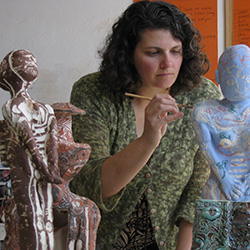|
I now know why the earth didn't touch the sky in the landscape pictures the children drew for me years ago. I taught art to pre-school and elementary-school students for years in the U.S., South Africa and Australia. In spite of the different environments, teaching these children was remarkably the same. They drew hills and houses, apartments or huts, trees filled with apples or mangoes, people with stick arms and legs spreading out of box-shaped bodies, standing still, holding hands and smiling beneath their geometric hair-dos. In the sky was always the sun and around the sun was a bright blue that flooded down the page a few inches and stopped abruptly at a thick, forbidding line. Children do this all over the world—leave this gap between the land and the sky. I never once suggested to these children that they drop the sky to meet the earth. I never explained that the sky was really an atmosphere—surrounding the earth, filling their lungs: they knew better.
These drawings still fascinate me. There is something poignant about the way the drawn scene is positioned on top of the earth—not in it; and beneath the sky—rather than surrounded by it. In these drawings a space has been formed that can be filled with everything that matters: a treasure chest of stick-figure families, houses, dogs, and fruit-rich trees. For me, this is what good writing does—it breaks open a chasm in the known world and gives the reader a new, captivating place to dwell. This is a space that is framed by the world, but not a part of it. A space that puts into words or images the things that we do not know how to explain or relate to in our lives. This space asks questions that the reader thinks he or she knows the answers to, but—in this white void, without history or foundation—finds are more complex than expected. This is not a space that is removed from the world, but one that looks directly at it, one that walks upon it. Not a safe or stable space, but a space that is constantly evolving and that at any moment threatens to close the gaps it has created, to shatter the delicate suspension of disbelief and collapse to crush its treasures.
For the writer, this space offers an endless stage where the rules of memory, time, and engagement are malleable; and where boundaries can be tested and altered. As a writer, I am always trying to create and enter this space: to claim it or to be claimed by it. To craft a good narrative, I must allow myself to be consumed completely by the emotions of this space; engulfed by the smells, sights, sounds and sensations; to understand the scenes as the characters understand them. But I must also remain objective: I am a guide, and my ambition is to bring the reader with me—to open a space that is wide enough for the reader and me to inhabit together; to balance the uncanny and ephemeral ideas that I explore with characters and scenes that are accessible to the reader. This constructed space is unfolding on a two-dimensional sheet of paper, a world within a larger world. It is this awareness, as much as the ability to create, that allows me to truly see a story and that which is revealed by it.
As an adult I seem to have lost some of the adventurousness that allowed me to journey into these undefined spaces so easily before I knew so much. When I started teaching beginning drawing to undergraduates, I found that the students imposed the logic of the horizon line on their own work: they had long forgotten a sky so heavy that it needed to be pushed away from the fragile flowers that lined the grass. In creative writing, older students were afraid to put something on paper that might be imperfect, which may not have captured exactly what they meant, which may have revealed too much of themselves. To crack open that space takes courage. I often think that the best way for my students to start would be to sit with pre-school children, a package of markers and the white space open before them.
|


